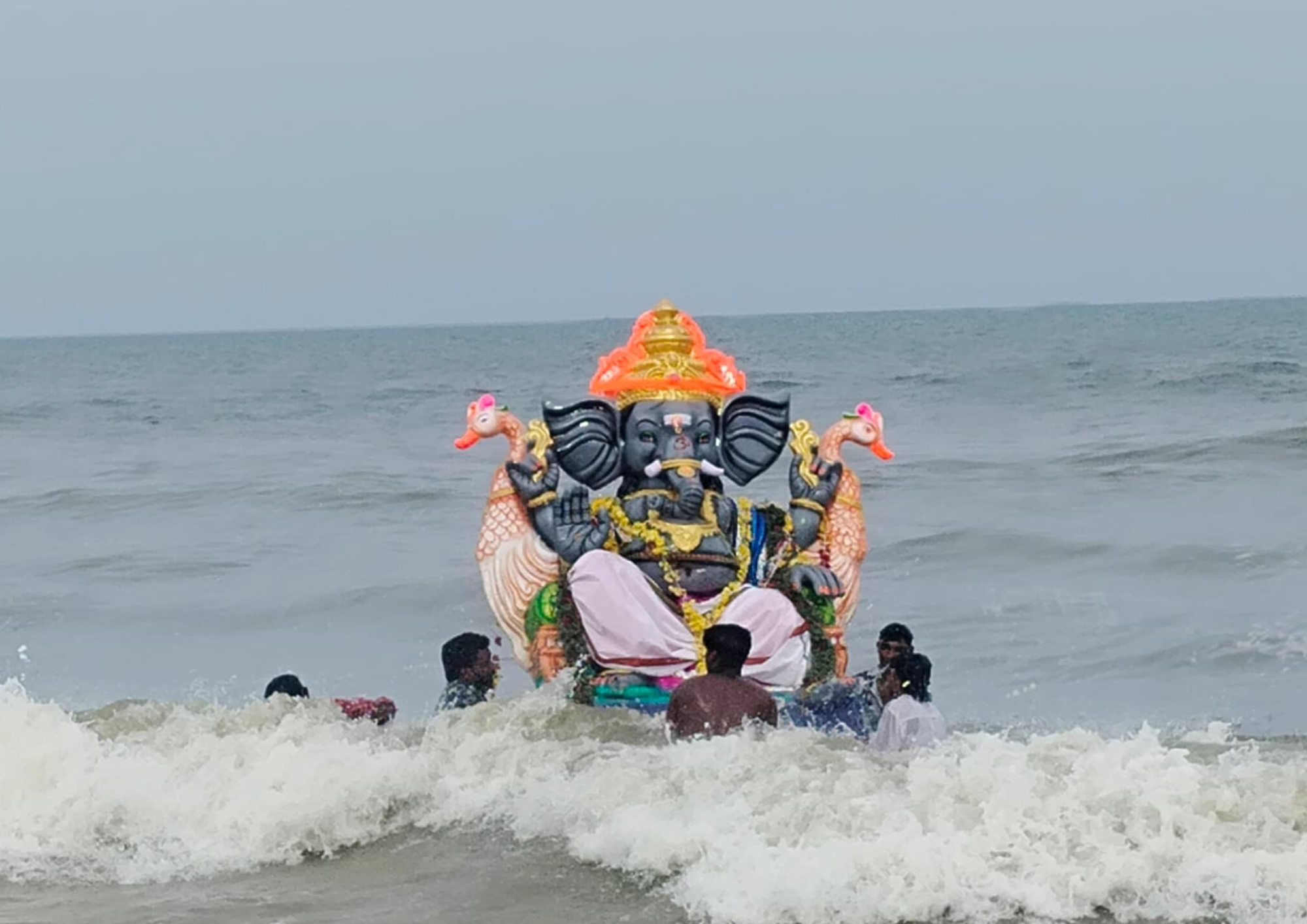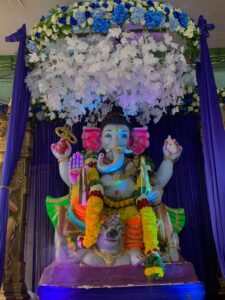The festival has been celebrated grandly in Tamil Nadu since the 1980s. Traditionally, large idols were installed, pujas conducted for 10 days, and then immersed in the sea.
Published Sep 02, 2025 | 12:00 PM ⚊ Updated Sep 26, 2025 | 11:24 AM

Vinayagar idol immersion at Pattinapakkam beach in Chennai.
Synopsis: In Tamil Nadu, youngsters are installing Vinayagar idols annually, often designed around contemporary themes. Devotees find satisfaction in their week of worship, while youngsters take pride in conducting the event on such a large scale across every neighbourhood. Yet, the political ripples generated by this festival in Tamil Nadu are likely to linger until the next Vinayagar Chaturthi.
You may not have heard the name “Operation Sindoor Vinayagar” before. According to Hindu mythology, Ganesha is worshipped in many forms and by many names. However, nowhere in Hindu texts does the name Operation Sindoor Vinayagar appear.
This is a new creation by the youngsters of Melatheru in Eral in the Thoothukudi district of Tamil Nadu, during the 2025 Vinayagar Chaturthi festival. Since 2008, these youngsters have been installing Vinayagar idols annually, often designed around contemporary themes.
Last year, they modelled Ganesha as Ayodhya Ram. This year, inspired by India’s counter-terror operation “Operation Sindoor” following the militant attack in Pahalgam, they dressed the deity in military attire and named him Operation Sindoor Vinayagar. The idol has since gone viral across social media.
Elsewhere, in Chennai’s RK Nagar, members of Tamilaga Vettri Kazhagam (TVK) created an idol depicting their leader Vijay signing a resolution in the 2026 Assembly, while in Hosur, Hindu groups installed a Vinayagar idol resembling Prime Minister Narendra Modi.
Such themed idols have become a trend, reappearing every year in different forms.
As always, colourful Ganesh idols across Tamil Nadu were immersed after a week-long celebration, from the Marina — the world’s second-longest beach — to rivers, ponds, and lakes across the state.
Devotees find satisfaction in their week of worship, while youngsters take pride in conducting the event on such a large scale across every neighbourhood.
Yet, the political ripples generated by this festival in Tamil Nadu are likely to linger until the next Vinayagar Chaturthi.
The festival has been celebrated grandly in Tamil Nadu since the 1980s. Traditionally, large idols were installed, pujas conducted for 10 days, and then immersed in the sea. But over time, citing law-and-order issues and traffic disruptions, the celebration period has reduced to a week or even three days.
This year, 1,519 idols were installed in Chennai and 2,300 in Coimbatore alone, with over 20,000 police personnel deployed in just these two districts—essentially one policeman per idol.
Statewide, over 50,000 idols were immersed this year, engaging more than 100,000 police officers. Last year, 64,217 police personnel were on duty for the festival.
According to The Vinayaka Chaturthi Festival and Hindutva in Tamil Nadu by CJ Fuller of the London School of Economics: In Chennai (then Madras), on Chaturthi day in 1983, a small group of Hindu activists belonging to the Hindu Munnani (“Hindu Front”), the Rashtriya Swayamsevak Sangh (RSS), and the BJP installed an image— or idol — of Vinayaka in a public place near a temple in West Mambalam, a suburb in the south-west of the city.
A few days later, they carried the idol in a procession for immersion in a temple tank.
One year later, idols were installed in several other localities, including Triplicane in the centre of the city. From this tiny beginning, the scale of public Vinayaka Chaturthi celebrations expanded fairly rapidly in Chennai.
By 1990, for the first time, a procession of many tall images, accompanied by thousands of Hindus, led to a violent clash with Muslims near the Ice House mosque in Triplicane, resulting in a bloody riot (Geetha and Rajadurai 1990; Pandian 1992).

Vinayaka idol in Chennai
Since then, similar incidents — ranging from small skirmishes to large-scale confrontations — have occurred from time to time. Even this year, in Chennai’s Pattabiram area, some mosques were covered with temporary screens as a precautionary measure to prevent such tensions from escalating.
In other parts of India, however, such clashes during Vinayaka Chaturthi processions are reported with greater frequency and are often considered a recurring feature of the festival.
Over the past five decades, the number of idols installed has steadily increased. But this year, the Tamil Nadu government did not permit new locations. Permissions were granted only where idols were installed in the previous year, such as Chennai, which had 1,519 spots both last year and this year. Unauthorised installations were met with arrests and cases.
But where did this festival truly begin?
According to writer and journalist Rajasangeethan, Vinayagar Chaturthi, as a mass celebration, was introduced in the 1890s by freedom fighter Bal Gangadhar Tilak to foster national unity.
“Before the 1990s, Ganesh Chaturthi was a private ritual. Some particular social groups alone installed small idols at home and immersed them in a well or even a bucket of water. But during colonial times, when the British banned political gatherings, Tilak transformed the festival into a 10-day mass celebration that doubled as a political platform,” said Rajasangeethan.
This move achieved two things: Mixing religion with nationalism for the first time and converting a caste-specific practice into a mass festival.
After Independence, however, the RSS and its affiliates adopted the festival, shifting its meaning. “What Tilak used as a symbol of Hindu unity against the British, the RSS reframed as a symbol of division,” he adds.
Despite state restrictions, idols continue to appear in unauthorised places. Those arrested or charged often find support from Hindu Munnani or BJP cadres.
Dinesh Kumar, who has been installing idols in Chennai for six years, explained: “We decide on the idol and approach Hindu Munnani. They provide the application to get details of the place, electricity, arrangements, and guide us from start to finish.”

Vinayaka in Rama attire
Balasurya, another youth who has worked with the Hindu Makkal Katchi, echoed the same: “If there’s a problem — police cases or legal trouble — they step in to help.”
These accounts confirm the organisational backing behind what appears to be spontaneous devotion.
Rajasangeethan points out: “When the state tries to restrict the festival citing law and order, the BJP and other Hindu organisations even turn that to their advantage — by assisting youngsters in dealing with legal cases, they strengthen their own base and expand their influence.”
Beyond politics and economics, the festival holds psychological significance. Most pandals are managed by local youngsters. Even with a conservative estimate of 10 people per pandal, at least 500,000 youngsters across Tamil Nadu are directly engaged.
Many are not politically inclined. But organising the festival, fundraising, marching with drums, and commanding community respect gives them a sense of power and recognition.
“When we started, people saw us as immature. Now, the area respects us,” said Dinesh.
Rajasangeethan recalled children from his neighbourhood leaving to collect money for Vinayagar celebrations in their street. “This creates in them a sense of authority and manhood. They begin to associate leadership with religious organisations.”
According to Rajasangeethan, commercial viability is central to Hindutva politics. “Any ideology that sustains itself must also generate income. Festivals like Ganesh Chaturthi combine devotion with an economic ecosystem — from idol-making to decorations, fundraising, and post-festival collections.”
Hindutva thrives because it is both symbolic and commercial. Rationalist or Marxist ideologies, by contrast, demand intellectual engagement. “Hindutva only asks that you identify as Hindu. Marxism requires reading books. Naturally, the easier path spreads faster,” he said.
In this context, innovations like Operation Sindoor Vinayagar emerge — a blend of devotion, commerce, and Hindutva symbolism.
Ramarajan, who organised the Sindoor Vinayagar idol in Thoothukudi, said: “We don’t belong to any party. Anyone can visit. But we plan this six months ahead, order the idol from Mumbai, and theme it around what is trending that year.”
As Rajasangeethan puts it: “The market is driven by novelty. Every year, a new twist is introduced to faith — serving both the organisers and Hindutva’s ideological growth. The strategy is to symbolise and commercialise religion.”
However, ordinary people often do not prefer idols styled after politicians or film stars.
Siva Malathi, a 23-year-old from Coimbatore who installs a Vinayagar idol at home every year, was critical: “These acts are nothing but imposing personal opinions through God. It’s unacceptable,” she insists.
She further warned that when political ideas are conveyed through religion, people may mistake propaganda for truth: “Because it comes through God, common people are more likely to believe it as correct.”
Therefore, as Rajasangeethan and several others argued, “Hindu right-wing organisations are using major Hindu festivals as instruments to push militant Hinduism, thereby laying the groundwork for division.”
For ordinary, non-political believers like Shiva Malathi, faith in God is purely about spirituality.
When politics is mixed into it, she feels, God is desecrated — turned into a partisan figure, a propaganda tool, and a vehicle for transmitting confusing and divisive ideas to people.
(Edited by Muhammed Fazil.)
